最澄 日本天台宗の開祖 延暦寺と大乗戒壇 『法華経』と『摩訶止観』

Enryaku-ji and Mahayana Ordination Platform: Saicho, Founder of Tendai Buddhism in Japan, Explores the Lotus Sutra and Mohe Zhiguan
イントロダクション
最澄は、平安時代に日本へ天台宗をもたらした偉大な僧侶です。
彼の創建した延暦寺は、その教えの中心地として知られ、大乗仏教の精神を体現しています。
『法華経』の普及に尽力し、『摩訶止観』を通じて瞑想の実践を広めた最澄の業績は、今も多くの人々に影響を与え続けています。
この記事では、その歴史的背景と哲学的意義を探ります。
最澄とは-日本天台宗の開祖
最澄とは、794年に誕生し、822年に亡くなった日本の僧侶であり、日本天台宗の開祖として知られています。
彼は伝教大師とも称され、中国から伝わった天台宗の教えを日本に定着させた重要な人物です。
最澄の思想と宗教改革の影響は、比叡山延暦寺を中心に広がりました。
最澄の生涯は、平安時代初期の宗教的及び社会的変動の中で展開しました。
彼は若くして仏教に深い関心を持ち、804年に遣唐使として中国に渡り、天台宗の教えを学びました。
帰国後、比叡山に延暦寺を建立し、そこを天台宗の中心地としました。
延暦寺は、後の数々の僧侶たちによって拡張され、今日に至るまで日本仏教の重要な拠点となっています。
最澄は、『摩訶止観』という著作を通して、瞑想法としての止観(しゃかん)を日本に紹介しました。
この教えは、個人の悟りを深めるための実践的な指南として、多くの信者に受け入れられました。
また、彼は大乗戒壇を設け、『法華経』の教えに基づく戒律を伝え、日本仏教の道徳的基盤を固める役割を果たしました。
最澄の宗教改革は、仏教が日本の社会において果たす役割を再定義しました。
彼の教えは、学問的な側面だけでなく、日常生活における宗教的実践にも影響を及ぼしました。
最澄の死後も、彼の弟子たちはその遺志を継承し、天台宗を日本全土に広める基盤を築き上げました。
最澄の業績は、日本の仏教史だけでなく、文化や社会にも深い影響を与えています。
彼の生きた時代から約1200年が経過した今日でも、最澄と彼が築いた宗教的遺産は、多くの人々に尊敬され、学ばれ続けています。
Introduction
Saicho was a revered monk who brought Tendai Buddhism to Japan during the Heian period.
Founded by him, Enryaku-ji served as a pivotal center for his teachings, embodying the spirit of Mahayana Buddhism.
Saicho’s accomplishments include promoting the Lotus Sutra and popularizing meditation through the Mohe Zhiguan, continuing to influence many today.
This article explores the historical background and philosophical significance of Saicho’s legacy.
Saicho: Founder of Tendai Buddhism in Japan
Saicho, born in 794 and passing away in 822, is celebrated as the founder of Tendai Buddhism in Japan.
Also known as Dengyo Daishi, he played a crucial role in establishing the teachings of Tendai Buddhism, imported from China.
Saicho’s philosophical insights and religious reforms spread from Mount Hiei’s Enryaku-ji as their epicenter.
Living during a period of religious and societal transformation in early Heian Japan, Saicho developed a deep interest in Buddhism from a young age.
In 804, he journeyed to China as part of an envoy mission and studied the teachings of Tendai Buddhism.
Upon his return, he founded Enryaku-ji on Mount Hiei, establishing it as the heart of Tendai Buddhism.
Enryaku-ji was expanded by subsequent monks and remains a crucial hub of Japanese Buddhism to this day.
Through his work “Mohe Zhiguan,” Saicho introduced the meditation practice of Shikan as a means to deepen individual enlightenment, which garnered widespread acceptance among believers.
He also established the Mahayana Ordination Platform, transmitting ethical guidelines based on the Lotus Sutra, thereby solidifying the moral foundation of Japanese Buddhism.
Saicho’s religious reforms redefined Buddhism’s role in Japanese society, influencing not only scholarly pursuits but also religious practices in daily life.
Even after his passing, Saicho’s disciples continued his legacy, spreading Tendai Buddhism throughout Japan.
His contributions have left a profound impact not only on Japanese Buddhist history but also on its culture and society.
Nearly 1200 years since his time, Saicho and his religious legacy continue to be revered and studied by many.
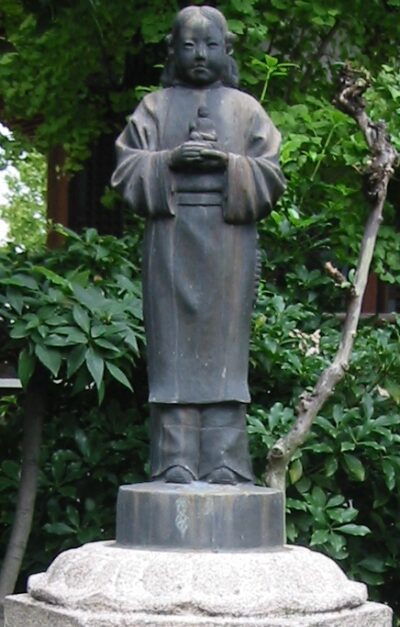
Saicho Statue at Nofuku-ji Temple
最澄の生涯と歴史的背景
最澄は794年に誕生し、日本の宗教史において重要な役割を果たした伝教大師として知られています。
彼は日本天台宗の開祖であり、その教えは比叡山延暦寺を中心に広がりました。
最澄の思想は、仏教の大乗戒壇の概念を日本に導入することにより、宗教改革の一翼を担いました。
彼の著作『摩訶止観』は、瞑想と修行の方法を説き、後の日本仏教に大きな影響を与えることとなります。
最澄の宗教的な業績は、彼が唱えた『法華経』に対する深い洞察にも見ることができます。
『法華経』への解釈は、天台宗の教義を形成する基盤となり、広く信者たちに受け入れられました。
また、最澄は、比叡山延暦寺を教育と修行の場として確立し、多くの僧侶を育成して日本仏教の発展に寄与しました。
最澄の歴史的背景を探ると、彼が活躍した時代は平安時代の初期にあたり、仏教は国家と深く結びついていました。
この時代、仏教は国家の保護を受け、さまざまな宗派が生まれ、発展していったのです。
最澄自身も、このような環境の中で学び、成長し、最終的には自らの宗派を立ち上げるに至りました。
伝教大師最澄の生涯は、日本仏教史において非常に重要であり、彼が残した教えは今日に至るまで多くの人々に影響を与え続けています。
比叡山延暦寺は、彼の遺産を今に伝える聖地として、多くの信者や訪問者を迎え入れています。
最澄と日本の宗教改革
最澄は、平安時代初期に活躍した僧であり、日本天台宗の創始者として知られています。
彼は伝教大師とも尊称され、仏教教義の深化と日本の宗教風土の改革に大きな影響を与えました。
最澄の生涯は、宗教だけでなく、政治や文化にも関わる多岐にわたる活動を展開したことで知られています。
最澄は、764年に誕生し、若くして仏教に深い関心を持ちました。
彼は中国の天台宗を学び、その教えを日本に持ち帰ることを決意しました。
帰国後、最澄は比叡山延暦寺を建立し、日本天台宗の中心地としました。
延暦寺は、学問と修行の場として多くの僧侶を育成し、日本仏教の発展に寄与しました。
最澄が著した『摩訶止観』は、瞑想法としての止観を詳細に説明したもので、天台宗の修行法の根幹をなす文献です。
このテキストを通じて、最澄は仏教の実践的な面を強調し、内省と悟りを重視する教義を広めました。
また、最澄は大乗戒壇を設立し、日本独自の戒律システムを確立しました。
これにより、日本仏教は中国や朝鮮半島の影響から独立した形で発展することとなります。
最澄が重視した『法華経』は、彼の教えの中核をなす経典であり、一切衆生の仏性を説くことで広く信仰されました。
最澄の宗教改革は、単に教義の伝播にとどまらず、当時の日本社会における宗教の位置づけを変革するものでした。
彼の努力により、仏教はより広範囲の人々に受け入れられ、日本の精神文化に深く根ざすこととなりました。
最澄の死後も、彼の教えは多くの僧侶によって受け継がれ、今日に至るまで日本の仏教界において大きな影響を持ち続けています。
Saicho’s Life and Historical Background
Saicho, born in 794, played a pivotal role in Japanese religious history as the revered founder of Tendai Buddhism.
He established Japan’s Tendai sect, with its teachings spreading from Mount Hiei’s Enryaku-ji.
Saicho’s philosophical contributions included introducing the concept of Mahayana Ordination Platform to Japan, a significant aspect of religious reform.
His work “Mohe Zhiguan” elucidated methods of meditation and practice, profoundly influencing later Japanese Buddhism.
Saicho’s religious achievements also reflect deep insights into the “Lotus Sutra,” forming the doctrinal foundation of Tendai Buddhism widely embraced by followers.
Moreover, Saicho founded Enryaku-ji on Mount Hiei as a center for education and practice, nurturing many monks who contributed to the development of Japanese Buddhism.
Exploring the historical backdrop of Saicho reveals his era coincided with early Heian period, where Buddhism was closely intertwined with the state.
During this time, Buddhism received state patronage, leading to the emergence and growth of various sects.
Saicho himself studied and thrived in this environment, eventually founding his own sect.
Saicho’s life as Dengyo Daishi is profoundly significant in Japanese Buddhist history, and his teachings continue to influence many to this day.
Enryaku-ji remains a sacred site preserving his legacy, welcoming countless believers and visitors.
Saicho and the Religious Reforms in Japan
Saicho, a monk active during the early Heian period, is renowned as the founder of Japan’s Tendai sect.
Also honored as Dengyo Daishi, he deeply impacted the refinement of Buddhist doctrines and the reform of Japan’s religious landscape.
Saicho was born in 764 and displayed a profound interest in Buddhism from a young age.
Studying the Tendai teachings in China, he resolved to bring these teachings back to Japan.
Upon his return, Saicho founded Enryaku-ji on Mount Hiei, establishing it as the spiritual center of Tendai Buddhism in Japan.
Enryaku-ji became a center for study and practice, training numerous monks and contributing to the growth of Japanese Buddhism.
Saicho’s seminal work, “Mohe Zhiguan,” detailed meditation practices essential to Tendai Buddhism’s spiritual discipline.
Through this text, Saicho emphasized practical Buddhism, focusing on introspection and enlightenment.
Additionally, Saicho established the Mahayana Ordination Platform, creating a unique disciplinary system for Japan independent of Chinese and Korean influences.
His emphasis on the “Lotus Sutra” as a core scripture preaching the Buddha nature of all sentient beings gained widespread faith.
Saicho’s religious reforms extended beyond doctrinal propagation, reshaping the role of religion in Japanese society at the time.
Thanks to his efforts, Buddhism gained broader acceptance and became deeply rooted in Japan’s spiritual and cultural heritage.
Even after Saicho’s passing, his teachings were carried on by many monks and continue to exert significant influence within Japan’s Buddhist community today.
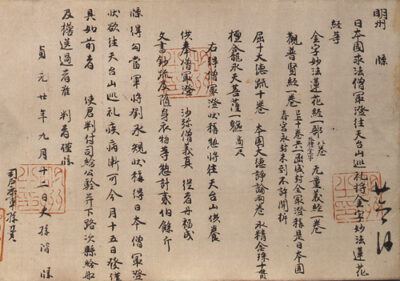
The “Denkyo Daishi’s Journey to China” Document: The Mingzhou Scroll (Treasured at Enryaku-ji, Designated National Treasure)
日本天台宗の教えとその展開
日本天台宗は、最澄によって開かれた仏教宗派であり、彼は伝教大師とも称されます。
最澄以前の天台教学は、中国で発展した天台三大論を基にしており、日本への伝来前からすでに一定の教義体系が確立されていました。
しかし、最澄が唐に渡って天台教学を学び、帰国後に比叡山延暦寺を建立することで、日本独自の天台宗が花開くこととなりました。
最澄は、『摩訶止観』をはじめとする天台教学の核心テキストを用いて、修行者に内観と智慧の重要性を説きました
。また、大乗戒壇を設け、『法華経』に基づく戒律を強調し、日本仏教における戒律の枠組みを整備しました。
これらの教えは、後の日本仏教に大きな影響を与え、多くの僧侶や信徒に受け継がれていきました。
天台密教は、天台宗の教えに密教的要素を取り入れたもので、独自の修行法や儀式が特徴です。
密教の要素を組み入れることで、教義の深化とともに、より実践的な修行の道が開かれました。
最澄は四宗兼学の精神を持ち、他宗派の教えも積極的に取り入れることで、天台宗の教義を深め、多元的な展開を見せました。
彼のこの姿勢は、後世の日本仏教においても多様性を保つための重要な原則となっています。
このように、最澄とその弟子たちによって築かれた日本天台宗は、比叡山延暦寺を中心に発展し、日本仏教の歴史において重要な位置を占めています。
その教えは、時代を超えて現代にも影響を与え続けており、仏教思想の理解には欠かせない要素となっています。
最澄以前の天台教学
天台宗は、中国の天台山に由来する仏教の一派であり、日本においては最澄によって開かれました。
しかし、最澄が伝教大師として知られる以前にも、天台教学は存在していました。
最澄の時代以前の天台教学は、中国で発展した大乗仏教の教義に基づき、『法華経』を中心とした教えが特徴です。
中国の天台宗は、智顗(ちぎ)という高僧によって確立され、『摩訶止観』という重要なテキストを通して、瞑想実践と哲学的思考が統合されていました。
日本における天台教学の導入は、最澄が唐に渡って天台宗の教えを学び、帰国後に比叡山延暦寺を建立し、そこを中心として広めたことに始まります。
最澄は、天台宗の包括的な教義体系を構築し、特に『法華経』に基づく教義を重視しました
。加えて、彼は大乗戒壇を設けることで、日本の天台宗における修行体系を確立させたのです。
最澄以前の天台教学においては、『法華経』の普遍的な教えと、瞑想実践に重きを置いた教義が中国で展開されていましたが、日本における最澄の教学は、これらの教えを受け継ぎつつ、日本独自の宗教文化と融合させることで、新たな展開を見せたのです。
最澄以前の天台教学の流れを受け継ぎながら、最澄は日本の土壌に合わせた教学を展開し、天台宗を日本の宗教風土に根付かせたのでした。
最澄入唐以後の天台教学
最澄が唐に渡った後の天台教学は、日本仏教の発展において重要な転換点となりました。
彼は伝教大師として知られ、天台宗の教えを日本に根付かせるために比叡山延暦寺を建立しました。
この地で、最澄は『摩訶止観』を中心に大乗仏教の教義を展開し、大乗戒壇を設けることで戒律の重要性を強調しました。
また、『法華経』に基づく教えを深化させ、日本固有の天台宗の教学を発展させたのです。
最澄以前の天台教学は中国の天台大師・智顗の教えに基づいていましたが、最澄入唐以後、日本の文化的背景を踏まえた独自の解釈が加わりました。
天台密教として知られる教えは、密教の要素を取り入れつつも、天台宗独自の特徴を持ち合わせていました。
これにより、日本の天台宗は、中国の天台宗とは異なる道を歩むことになります。
最澄の教えは、四宗兼学の精神にも表れています。
彼は天台宗の教えを核としつつも、他宗派の教えも尊重し、それらを統合することで、より幅広い視野から仏教を理解することを目指しました。
これは、比叡山延暦寺が多様な学問と修行の場として発展する基盤となり、後の多くの僧侶に影響を与えることになります。
最澄の功績は、日本の天台宗の開祖としてだけでなく、仏教教学全般における深い洞察と実践的な指導にも見られます。
彼の教えは、時代を超えて今日の仏教研究にも重要な影響を与えています。
天台密教とその特徴
天台密教は、日本における密教の流れを汲む独特の宗教形態です。
最澄、またの名を伝教大師として知られる彼は、日本天台宗の開祖として比叡山延暦寺を創建しました。
彼の教えは、『摩訶止観』や『法華経』を中心として展開され、大乗戒壇の確立にも寄与しました。
最澄以前の天台教学は、中国で発展した天台思想が基盤となっていますが、最澄入唐以後の天台教学は、彼の経験と理解を通じて日本独自の色彩を帯びるようになりました。
特に、天台密教は、大乗仏教の普遍性と、密教特有の秘密の儀式や修行法を融合させたものです。
この宗派は、四宗兼学の精神を重んじ、他の仏教宗派の教えも取り入れながら、天台宗独自の教義体系を構築しました。
この柔軟性と包括性は、天台宗が日本の仏教界において大きな影響力を持つ一因となっています。
天台密教の特徴は、教義だけでなく、瞑想法や修験道との関連も深いことから、日本の宗教文化において特異な位置を占めています。
最澄の教えが今日に至るまで受け継がれ、多くの信者によって実践されているのは、その普遍的な教えと実践的な修行法が人々の心に訴えかけるからでしょう。
四宗兼学の精神
日本天台宗の教えは、最澄、または伝教大師として知られる偉大な僧侶によって確立されました。
彼は日本の天台宗の開祖であり、中国からの天台教学をもたらした人物です。
最澄以前の日本における仏教教学は、まだ統一された体系を持っていませんでしたが、最澄の入唐とその後の教学の展開により、日本仏教は大きな転換点を迎えます。
最澄が唐から持ち帰った教えは、比叡山延暦寺を中心に展開しました。
延暦寺は、日本天台宗の総本山として、多くの僧侶たちの修行の場となり、天台教学の拠点として重要な役割を果たしました。
最澄は、『摩訶止観』を基に実践的な修行法を確立し、「大乗戒壇」を設けることで、僧侶たちが戒律を学び、守ることの重要性を説きました。
また、最澄は『法華経』を中心とした教義を重視し、その普遍的な教えを広めることに尽力しました。
彼の教えは、天台密教としても知られるようになり、独自の特徴を持つ日本の仏教宗派として発展しました。
天台密教は、真言宗など他の密教宗派とは異なる独特の修行体系と密教儀式を持ち、四宗兼学の精神を体現しました。
これは、異なる教義や宗派の教えを包括的に学び、それらを統合する精神を指します。
最澄の教えは、その後の日本仏教に大きな影響を与え、多くの僧侶や信徒によって受け継がれてきました。
四宗兼学の精神は、他宗派の教えにも開かれた寛容な姿勢を示し、日本の仏教文化の多様性と深さを象徴しています。
最澄の思想と実践は、今日においても多くの人々に尊敬され、学ばれ続けているのです。
The Teachings and Development of Japanese Tendai Buddhism
Japanese Tendai Buddhism, founded by Saicho, also known as the Denkyo Daishi, plays a significant role in Japanese religious history.
Before Saicho, Tendai teachings were based on the Tendai Three Treatises developed in China, establishing a doctrinal system before their introduction to Japan.
However, Saicho’s journey to China to study Tendai teachings and his subsequent founding of the Enryaku-ji on Mount Hiei led to the flourishing of Japan’s unique Tendai tradition.
Saicho utilized core texts like the “Maka Shikan” to emphasize the importance of introspection and wisdom for practitioners.
He also established the Great Precept Platform, emphasizing the Vinaya based on the Lotus Sutra, thereby structuring the framework of monastic discipline in Japanese Buddhism.
These teachings exerted a profound influence on later Japanese Buddhism, passed down to many monks and believers.
Tendai Esoteric Buddhism incorporates esoteric elements into Tendai teachings, featuring distinct practices and rituals.
By integrating esoteric elements, it not only deepened doctrinal understanding but also opened up a more practical path of spiritual cultivation.
Saicho embraced the spirit of “learning from all four sects,” actively incorporating teachings from other sects to enrich Tendai doctrines and foster diverse development.
His approach became a crucial principle for maintaining diversity within Japanese Buddhism.
Thus, Japanese Tendai Buddhism, established by Saicho and his disciples, centered around Mount Hiei’s Enryaku-ji, occupies a significant place in Japanese Buddhist history.
Its teachings continue to influence contemporary Buddhist thought, constituting an indispensable element for understanding Buddhist philosophy today.
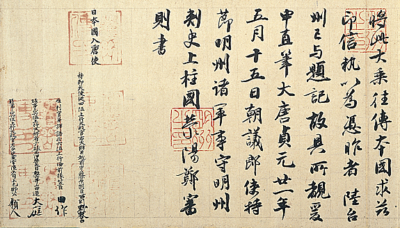
“Catalog of the Invitation of the Great Teacher (Koshu-roku)”
(Handwritten by Saicho, Preserved at Enryaku-ji Temple, National Treasure)
比叡山延暦寺-天台宗の中心
比叡山延暦寺は、滋賀県にある天台宗の総本山であり、日本の天台宗を開いた最澄によって創建されました。
この聖地は、最澄が唐から持ち帰った『摩訶止観』の教えを広め、日本仏教の新たな地平を開いた場所として知られています。
最澄、後に伝教大師と称される彼の思想と宗教的実践は、比叡山延暦寺を通じて数多くの僧侶や信者に影響を与えました。
延暦寺の歴史は、794年に最澄が比叡山に小堂を設けたことに始まります。
その後、最澄は天台宗の教えを体系化し、多くの寺院や施設を建て、大乗戒壇としての地位を築きました。
大乗戒壇とは、菩薩戒を授ける場所であり、最澄が確立した日本独自の戒壇です。
ここでは、多くの修行僧が『法華経』を学び、瞑想や修行を行いました。
延暦寺には、多くの主要寺院があり、それぞれが重要な役割を果たしています。
中でも、根本中堂、東塔、西塔は、延暦寺の三大堂として知られ、天台宗の教義を象徴する建築物です。
これらの寺院は、最澄の教えを今に伝え、多くの人々が参拝や修行のために訪れる聖地となっています。
比叡山延暦寺は、最澄の教えとその歴史的背景を理解する上で欠かせない場所であり、天台宗の中心地としての役割を今も継続しています。
この聖地は、伝教大師最澄の精神を今に伝えるとともに、日本仏教文化の重要な遺産として世界にその価値を示しています。
延暦寺の歴史と最澄の関わり
延暦寺は、794年に最澄によって創建された比叡山にある寺院で、日本の天台宗の総本山として知られています。
最澄は、その後伝教大師と称されるようになり、中国から持ち帰った天台宗の教えを広めるために尽力しました。
彼の教えは、大乗仏教の教義に基づいており、特に『法華経』の普及に貢献しました。
最澄が比叡山に築いた大乗戒壇は、日本における仏教戒律の中心地となり、多くの僧侶がここで受戒しました。
この戒壇は、日本仏教における修行の場として重要な役割を果たし、天台宗の教義を体系化する基盤を築きました。
また、最澄は『摩訶止観』という著作を通じて、瞑想と智慧を深めるための方法を詳細に説明し、これが天台宗の修行法として広く受け入れられることになります。
延暦寺の主要寺院は、それぞれ特定の宗教的役割を担い、天台宗の教義を守り、伝えるための中心地として機能しました。
最澄と延暦寺の関わりは、日本の仏教史において非常に重要であり、現在でも多くの人々がその歴史的価値を訪れ、学ぶために比叡山を訪れています。
最澄の教えと延暦寺の存在は、日本の文化や精神性に大きな影響を与え続けているのです。
大乗戒壇とは-最澄の功績
日本の天台宗の開祖である最澄、またの名を伝教大師は、比叡山延暦寺の創建者として知られています。
彼の生涯において、大乗戒壇の設立は特筆すべき功績の一つです。
最澄が唱えた教えは、『法華経』に基づいており、その中でも特に『摩訶止観』は彼の思想を深く理解する上で重要なテキストとされています。
比叡山延暦寺は、最澄が天台宗の教義を広めるための拠点として建立しました。
この地には、最澄が中国から持ち帰った多くの仏教経典や教義が保存され、後の日本仏教文化に大きな影響を与えました。
延暦寺の歴史は、最澄の足跡と深く結びついており、彼の教育と修行の場としての役割は計り知れません。
大乗戒壇とは、最澄が比叡山に設けた戒律を授ける場所です。
ここでの戒律授与は、天台宗の僧侶が修行を積み、高い精神性を身につけるための重要な儀式とされています。
最澄は、戒律を通じて弟子たちに、仏教の教えを実践することの重要性を説きました。
延暦寺には、多くの主要寺院が存在し、それぞれが天台宗の修行や教育における特定の役割を担っています。
これらの寺院は、最澄の思想を今に伝えるとともに、仏教の教えを学び、修行を積む僧侶たちの心の拠り所となっています。
最澄の功績は、単に延暦寺や大乗戒壇の設立にとどまらず、日本仏教の土台を築いたことにあります。
彼の教えは、後世の僧侶や学僧によって受け継がれ、日本の文化や思想に深く根ざしているのです。
Enryaku-ji Temple – Center of Tendai Buddhism
Enryaku-ji Temple, located in Shiga Prefecture, is the head temple of Tendai Buddhism in Japan, founded by Saicho, who opened the Tendai school in Japan.
This sacred site is renowned as the place where Saicho propagated the teachings of the “Maka Shikan” brought back from Tang China, ushering in a new horizon for Japanese Buddhism.
Saicho, later known as Dengyo Daishi, influenced numerous monks and believers through his philosophical thoughts and religious practices at Enryaku-ji Temple.
The history of Enryaku-ji Temple dates back to 794 when Saicho established a small hall on Mount Hiei.
Subsequently, Saicho systematized the teachings of Tendai Buddhism, constructing many temples and facilities, and establishing the position of the Great Ordination Platform.
The Great Ordination Platform is where the Bodhisattva precepts are conferred, representing a unique Japanese Buddhist ordination platform established by Saicho.
Here, many monks studied the “Lotus Sutra” and engaged in meditation and ascetic practices.
Enryaku-ji Temple comprises several major halls, among which the Konpon Chudo, To-to, and Sai-to are known as the Three Great Halls of Enryaku-ji Temple, symbolizing the doctrines of Tendai Buddhism.
These temples continue to transmit Saicho’s teachings to this day, attracting many people as a sacred site for worship and practice.
Enryaku-ji Temple remains indispensable for understanding Saicho’s teachings and their historical context, continuing to serve as the focal point of Tendai Buddhism.
This sacred place not only perpetuates the spirit of Dengyo Daishi Saicho but also showcases its significance as a crucial heritage of Japanese Buddhist culture to the world.
History of Enryaku-ji Temple and Its Connection to Saicho
Enryaku-ji Temple, located on Mount Hiei, was founded in 794 by Saicho and is renowned as the head temple of Tendai Buddhism in Japan.
Later known as Dengyo Daishi, Saicho made efforts to propagate the teachings of Tendai Buddhism brought back from China.
His teachings, based on the doctrines of Mahayana Buddhism, particularly contributed to the dissemination of the “Lotus Sutra.”
The Great Ordination Platform established by Saicho on Mount Hiei became the central place for Buddhist precepts in Japan, where many monks received ordination.
This platform played a crucial role as a place of practice in Japanese Buddhism, establishing the foundation for the doctrines of Tendai Buddhism.
Moreover, Saicho detailed methods for meditation and wisdom through his work “Maka Shikan,” widely accepted as the practice of Tendai Buddhism.
The major halls of Enryaku-ji Temple each served specific religious roles, safeguarding and transmitting the doctrines of Tendai Buddhism.
The connection between Saicho and Enryaku-ji Temple is profoundly significant in Japanese Buddhist history, attracting many to Mount Hiei to learn about its historical value.
Saicho’s teachings and the existence of Enryaku-ji Temple continue to exert a profound influence on Japanese culture and spirituality.
The Great Ordination Platform – Saicho’s Achievement
Saicho, also known as Dengyo Daishi, the founder of Japan’s Tendai Buddhism, is renowned for establishing Enryaku-ji Temple on Mount Hiei.
One of his notable achievements in life was the establishment of the Great Ordination Platform.
Saicho’s teachings were based on the “Lotus Sutra,” and his work “Maka Shikan” is particularly crucial for understanding his philosophical thoughts deeply.
Enryaku-ji Temple was founded as a base for propagating the teachings of Tendai Buddhism by Saicho.
Many Buddhist scriptures and doctrines brought back from China by Saicho are preserved here, greatly influencing later Japanese Buddhist culture.
The history of Enryaku-ji Temple is deeply intertwined with Saicho’s footsteps, and its role in education and practice cannot be overstated.
The Great Ordination Platform is where Saicho established rules for Buddhist ordination.
The conferral of ordination here was an important ritual for monks of Tendai Buddhism to cultivate high spirituality through practice.
Enryaku-ji Temple houses many major halls, each playing a specific role in Tendai Buddhism’s practice and education.
These temples not only transmit Saicho’s teachings to this day but also serve as spiritual sanctuaries for monks learning Buddhist doctrines and practicing asceticism.
Saicho’s achievements extended beyond the establishment of Enryaku-ji Temple and the Great Ordination Platform to laying the foundation of Japanese Buddhism.
His teachings have been passed down by later monks and scholars, deeply rooted in Japanese culture and thought to this day.
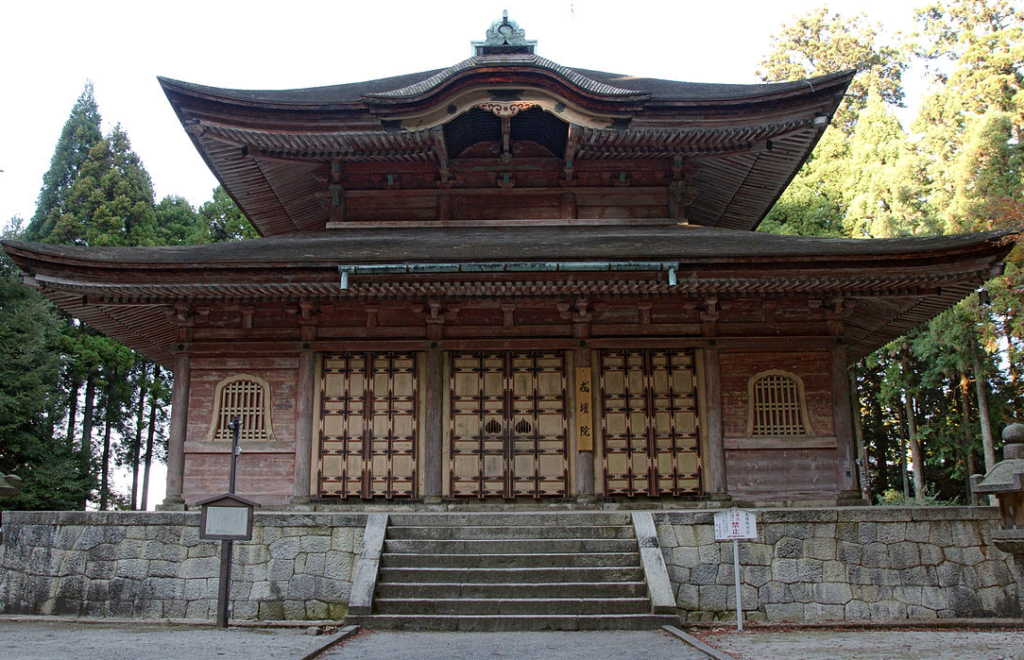
Enryaku-ji Kaidan-in (Important Cultural Property)
延暦寺の主要寺院とその役割
比叡山延暦寺は、最澄によって創建された日本天台宗の総本山です。
最澄、またの名を伝教大師は、日本に天台宗をもたらした宗教家であり、その教えは『摩訶止観』に集約されています。
延暦寺は比叡山の山頂に位置し、多くの主要寺院から構成され、それぞれが独自の役割を果たしています。
最澄は中国から天台宗の教えを日本に伝え、比叡山に大乗戒壇を設立しました。
これは日本で初めての本格的な僧侶の戒律伝授の場であり、『法華経』に基づいた修行を行うための重要な施設です。
延暦寺の主要寺院の一つには、この大乗戒壇が含まれ、多くの僧侶がここで修行を積んできました。
延暦寺の主要寺院には、東塔、西塔、横川などがあり、それぞれが最澄の教えを守り、伝える役割を担っています。
東塔は最澄が最初に建立した場所であり、西塔は多くの重要な文化財を保有しています。
横川は修行僧の隠遁の地として知られ、厳しい修行が行われています。
これらの寺院は、最澄が確立した天台宗の教義を守り、伝えるとともに、比叡山延暦寺を日本の仏教文化の中心地として重要な役割を果たしています。
最澄の功績は、延暦寺の各寺院に今も息づいており、日本仏教の歴史において不可欠なものとなっています。
Principal Temples of Enryaku-ji and Their Roles
Enryaku-ji on Mount Hiei is the head temple of the Tendai sect in Japan, founded by Saicho.
Saicho, also known as Dengyo Daishi, introduced the Tendai sect to Japan, encapsulating his teachings in the “Maka Shikan.”
Located at the summit of Mount Hiei, Enryaku-ji consists of numerous principal temples, each serving distinct roles.
Saicho brought the teachings of the Tendai sect from China to Japan and established the Great Precept Platform on Mount Hiei.
This was the first formal place in Japan for the transmission of full monastic precepts and a significant facility for practicing based on the Lotus Sutra.
One of the principal temples of Enryaku-ji includes this Great Precept Platform, where many monks have trained over the centuries.
Among the principal temples of Enryaku-ji are the East Pagoda, West Pagoda, and Yokawa, each responsible for preserving and transmitting Saicho’s teachings.
The East Pagoda was the first established by Saicho, while the West Pagoda holds many important cultural assets.
Yokawa is known as a place of seclusion for practicing monks, engaging in rigorous ascetic practices.
These temples uphold and transmit the Tendai sect doctrines established by Saicho, playing a crucial role in Mount Hiei Enryaku-ji as a center of Japanese Buddhist culture.
Saicho’s achievements continue to resonate within each temple of Enryaku-ji, remaining indispensable to the history of Japanese Buddhism.
最澄の教えと著作
最澄、伝教大師として知られるこの偉人は、日本天台宗の開祖として尊敬されています。
彼の影響は、比叡山延暦寺にその根を持ち、そこから日本仏教文化に深く根ざしています。
最澄の教えは、『摩訶止観』に集約されており、このテキストは天台宗の中心的な教義を形作っています。
『摩訶止観』では、心を静める「止」と深い洞察を得る「観」を組み合わせた瞑想法が説かれており、これは修行者が悟りへの道を歩むための基礎とされています。
また、最澄は『法華経』を天台宗の核と位置づけ、その普遍的な教えを日本に広めました。
『法華経』に基づく大乗戒壇の概念は、修行者が菩薩の道を歩むための重要なステップとされています。
止観行の実践は、内観と外界への洞察を深めることで、個人の精神性を高めると同時に、周囲の生命との調和を促進するものです。
最澄の教えは、単に宗教的な枠組みに留まらず、個人の精神的な成長と社会全体の調和を目指す普遍的な価値を持っています。
その著作と実践は、今日においても多くの人々に影響を与え続けており、日本文化の一環として重要な位置を占めています。
『摩訶止観』とその教義
日本の天台宗を築き上げた最澄、またの名を伝教大師は、比叡山延暦寺を拠点に様々な教えを広めました。
その中でも特に重要な著作が『摩訶止観』です。
この文献では、大乗仏教の核心をなす「止観」の技法が詳述されており、瞑想と洞察の統合を通じて悟りに至る道筋を示しています。
『摩訶止観』の教義は、心を安定させる「止」の修行と、真理を洞察する「観」の修行の二つから成り立っています。
これらの修行を通じて、日常の煩悩に囚われることなく、究極の真実に到達することを目指します。
最澄は、『法華経』の教えを根底に置きながら、天台宗独自の修行法としてこれを体系化しました。
比叡山延暦寺では、最澄によって創設された大乗戒壇があり、そこで受ける戒律は天台宗の修行者にとって重要な意味を持ちます。
これらの戒律は、『摩訶止観』の教義を実践する上での道徳的な基盤となり、修行者が内面の浄化を図るための指針を提供します。
最澄の教えは、単なる理論に留まらず、止観行という実践を通して日々の生活に深く根ざしています。
その実践は、精神的な平和を得るためだけではなく、周囲の人々との調和をもたらし、社会全体の福祉に貢献することを目的としています。
日本の天台宗の開祖である最澄の教えと『摩訶止観』の教義は、今日においても多くの人々に影響を与え続けており、比叡山延暦寺を訪れる人々はその精神的な遺産に触れることができます。
最澄の思想に深く根差した天台宗の教えは、現代社会における精神的な指針としても価値が認められています。
Teachings and Writings of Saicho
Saicho, revered as the founder of Japan’s Tendai sect and known as Dengyo Daishi, has left an indelible mark on Japanese Buddhism centered at Enryaku-ji on Mount Hiei.
His teachings are encapsulated in the “Maka Shikan,” which forms the core doctrine of the Tendai sect.
“Maka Shikan” expounds a meditation practice combining calming the mind (止, shi) and gaining profound insight (観, kan), laying the foundation for practitioners on the path to enlightenment.
Moreover, Saicho positioned the Lotus Sutra (法華経, Hokke-kyo) as central to Tendai teachings, spreading its universal message throughout Japan.
The concept of the Great Precept Platform established by Saicho on Mount Hiei, based on the Lotus Sutra, serves as a crucial step for practitioners aspiring to walk the path of the Bodhisattva.
The practice of Shikan meditation aims to enhance personal spirituality through introspection and insight into the world, fostering harmony with all life.
Saicho’s teachings hold universal value, aiming not only for personal spiritual growth but also for fostering societal harmony, transcending mere religious framework.
His writings and practices continue to influence many to this day, holding a significant place within Japanese cultural heritage.
“Maka Shikan” and Its Doctrine
Saicho, also known as Dengyo Daishi, who founded Japan’s Tendai sect centered at Enryaku-ji on Mount Hiei, propagated various teachings, with “Maka Shikan” standing out as particularly significant.
This text details the meditation technique of “Shikan,” which lies at the heart of Mahayana Buddhism, integrating meditation and insight to illuminate the path to enlightenment.
The doctrine of “Maka Shikan” comprises two aspects: the practice of calming the mind (止, shi) and the practice of perceiving truth (観, kan), aiming to reach the ultimate truth without being bound by everyday delusions.
Saicho systematized these practices as unique to the Tendai sect, rooted in the teachings of the Lotus Sutra (法華経, Hokke-kyo).
Enryaku-ji on Mount Hiei houses the Great Precept Platform established by Saicho, where receiving these precepts holds significant meaning for Tendai practitioners.
These precepts serve as a moral foundation for practicing the doctrine of “Maka Shikan,” providing guidance for practitioners seeking inner purification.
Saicho’s teachings are deeply integrated into daily life through the practice of Shikan meditation, aiming not only for spiritual peace but also for fostering harmony with others and contributing to the welfare of society as a whole.
The teachings of Saicho, the founder of Japan’s Tendai sect, and the doctrine of “Maka Shikan” continue to influence many people today, offering visitors to Enryaku-ji on Mount Hiei an opportunity to connect with this spiritual legacy deeply rooted in Japanese culture.
The teachings of the Tendai sect, deeply rooted in Saicho’s philosophy, are recognized today as valuable spiritual guidelines in contemporary society.
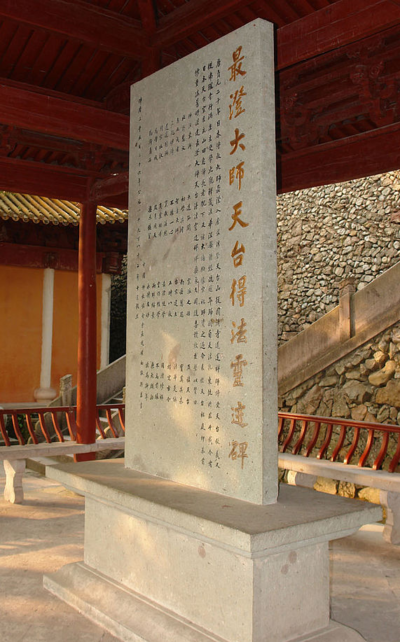
Inscription of Saicho’s Enlightenment (Kukisho-ji Temple on Mount Tendai)
『法華経』と天台宗
最澄は伝教大師の称号を持ち、日本天台宗の開祖として知られています。
彼が建立した比叡山延暦寺は、天台宗の中心地として長きにわたり多くの僧侶を育成してきました。
最澄の教えは、『法華経』を根本経典とし、その理解を深めるための『摩訶止観』という著作によって広まりました。
このテキストでは、止観行(瞑想実践)の方法が詳述されており、日常生活における大乗仏教の実践として重要な位置を占めています。
『法華経』に基づいた教義は、天台宗において中心的な役割を果たし、最澄自身もその普及に力を注ぎました。
大乗戒壇は、『法華経』に基づく戒律を授けるための場として設けられ、修行僧が戒律を守ることの重要性を学びます。
最澄の思想は、『摩訶止観』において展開される止観行の実践を通じて、内省的な修行と外向的な教化活動の双方に影響を与えました。
止観行は、心を静める「止」と事物の真実を観察する「観」の二つの側面から成り立ち、修行者が悟りに至るための道筋とされています。
最澄と天台宗、そして『法華経』の関連性は、日本仏教史上において非常に重要なテーマであり、最澄の教えがいかにして日本の宗教風土に根付いたかを理解する鍵を握っています。
止観行の実践と意義
止観行とは、最澄が提唱した独特の修行方法であり、自己の心を静め、真理を観察することを目的としています。
最澄は伝教大師の称号を持ち、日本の天台宗の開祖として知られており、比叡山延暦寺を中心にその教えを広めました。
彼の主著『摩訶止観』は、大乗仏教の精神を体系化し、日本仏教の発展に大きな影響を与えた文献です。
『摩訶止観』においては、瞑想を通じて心を止める「止」の段階と、深い洞察により真理を観る「観」の段階が説かれています。
この二つのプロセスを経て、最終的には悟りに至るとされています。
また、『法華経』に基づいた教義を土台に、大乗戒壇を設けることで、修行者が戒律を守りながら精神的な成長を遂げることができる環境を整えました。
止観行の実践は、単に座禅を組むことにとどまらず、日常生活の中での心の動きを観察し、煩悩から離れ、慈悲の心を育むことにも重点を置いています。
この実践を通じて、個人の内面だけでなく社会に対する貢献も意識され、天台宗が広く信仰される土壌が形成されました。
最澄の教えは、比叡山延暦寺をはじめ日本各地の天台宗寺院で今もなお受け継がれており、止観行の意義は現代においても多くの人々にとって重要な精神的支柱となっています。
The Lotus Sutra and Tendai Buddhism
Saicho, revered as the founder of Japanese Tendai Buddhism and honored with the title of Dengyo Daishi, established the renowned Mount Hiei Enryakuji as the central seat of Tendai Buddhism.
Saicho’s teachings centered around the Lotus Sutra, and his work “Maka Shikan” played a pivotal role in deepening understanding of this scripture.
“Maka Shikan” details the practice of Shikan meditation, combining the tranquility of “Shi” with insightful observation of reality, serving as a cornerstone for Mahayana Buddhist practices in daily life.
Based on the Lotus Sutra, the doctrines in Tendai Buddhism are foundational, and Saicho dedicated himself to their propagation.
The Great Ordination Platform, established under the Lotus Sutra, serves as a place for imparting precepts, emphasizing their significance for practitioners.
Saicho’s philosophy, as articulated through Shikan meditation, influenced both introspective practice and external propagation efforts. This method involves quieting the mind to achieve “Shi” and observing ultimate truths to achieve “Kan,” guiding practitioners toward enlightenment.
The connection between Saicho, Tendai Buddhism, and the Lotus Sutra represents a crucial theme in Japanese Buddhist history, offering insights into how Saicho’s teachings became ingrained in Japan’s religious culture.
The Practice and Significance of Shikan Meditation
Shikan meditation, advocated by Saicho, is a unique method aimed at calming one’s mind and observing truths.
Honored as Dengyo Daishi, Saicho is known as the founder of Japanese Tendai Buddhism, spreading his teachings centered at Mount Hiei Enryakuji.
His principal work, “Maka Shikan,” systematized the spirit of Mahayana Buddhism, profoundly influencing the development of Japanese Buddhism.
“Maka Shikan” delineates the stages of meditation: “Shi,” where the mind is stilled, and “Kan,” where profound insights into truth are gained, ultimately leading to enlightenment.
Additionally, establishing the Great Ordination Platform based on the Lotus Sutra provided an environment for practitioners to uphold precepts while achieving spiritual growth.
Shikan meditation isn’t confined to sitting meditation but extends to observing the movements of the mind in daily life, cultivating compassion and distancing oneself from afflictions.
Through this practice, not only personal inner growth but also contributions to society are emphasized, forming the fertile ground upon which Tendai Buddhism is widely revered.
Saicho’s teachings endure in Tendai temples across Japan, notably at Mount Hiei Enryakuji, where the significance of Shikan meditation continues to serve as a crucial spiritual pillar for many in modern times.
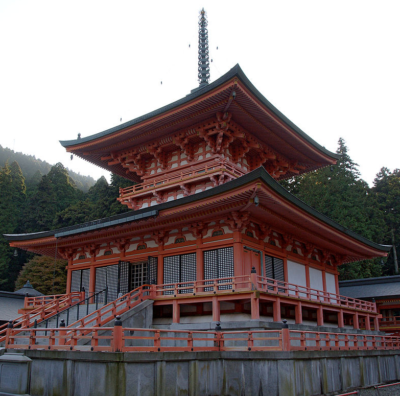
Eastern Pagoda of the Hokke Sojiin at Enryaku-ji Temple
最澄と他宗教との関係
最澄は、日本の天台宗の開祖として知られており、彼の教えは比叡山延暦寺を中心に広まりました。
彼は伝教大師とも称され、その思想は『摩訶止観』にも深く反映されています。
最澄と他宗教との関係は、特に空海との関係において、宗教対話の重要な一幕を飾ります。
空海は真言宗の祖として知られ、最澄とは異なる宗教観を持ちながらも、相互の尊敬と理解を基に交流がありました。
最澄の教えは、大乗戒壇を設立することで、『法華経』の精神を実践する場となり、多くの僧侶に影響を与えました。
天台宗の広がりは、最澄が他宗教とどのように関わり、また影響を受けたかを考察する上で重要な要素です。
彼の柔軟な思想は、異なる宗派の教えを取り入れることにも積極的であり、その結果、天台宗は多様な宗教的要素を内包する包容力のある教えとして発展しました。
最澄の生涯と教えは、日本の仏教史において重要な位置を占めており、彼と他宗教との関係を探ることは、日本の宗教的風土を理解する上で不可欠です。
彼の開いた道は、後世の宗教的交流にも大きな影響を与え、今日に至るまでその精神は多くの人々に受け継がれています。
空海との関係と宗教対話
空海と最澄は共に奈良時代末期から平安時代初期にかけて活躍した僧であり、日本仏教史において重要な役割を果たしています。
最澄は日本の天台宗を開いた人物として知られ、比叡山延暦寺を創建しました。
一方、空海は真言宗の開祖であり、彼らの交流は宗教対話の観点から非常に興味深いものです。
最澄が著した『摩訶止観』は天台宗の教義を固める上で中心的な役割を果たし、大乗戒壇を設けることによって日本仏教の形成に寄与しました。
最澄と空海は、同じ時期に中国へ渡り、それぞれ異なる仏教の教えを学びました。
帰国後、彼らは互いに尊敬し合いながらも、自己の宗派の教えを確立するために努力しました。
最澄は『法華経』を中心に置いた天台宗の教義を展開し、日本における仏教の新たな流れを作り出しました。
その教えは、比叡山延暦寺を中心に広まり、多くの学僧を育成しました。
空海との関係では、両者の間には書簡のやり取りがあり、宗教的な対話が行われていたことが記録されています。
この対話は、彼らの間の相互理解と尊重を示すものであり、異なる宗派間の交流の模範とも言えます。
最澄と空海の関係を通じて、日本仏教の多様性と深さが垣間見え、後の宗教間対話の基盤を形成しました。
また、最澄の影響は他宗教にも及び、天台宗の思想は日本の他の宗派や文化にも大きな影響を与えました。
最澄の教えは、比叡山延暦寺を通じて広く伝播し、日本の仏教思想の発展に寄与したのです。
このように、最澄と空海、そして彼らが築き上げた宗教対話は、日本仏教史における重要な節点となっています。
他宗教への影響と天台宗の広がり
最澄は、日本の天台宗を創始したことで知られる伝教大師です。
彼が建立した比叡山延暦寺は、天台宗の中心地として多くの僧侶を育成し、日本仏教の発展に大きな影響を与えました。
最澄の著作『摩訶止観』は、天台宗の教義を詳細に説明したものであり、大乗戒壇と結びつけられ、修行者にとっての道しるべとなりました。また、
彼は『法華経』を中心とした教えを強調し、その普及に尽力しました。
空海と最澄は、同時代を生きた僧であり、宗教対話を通じて互いに影響を受けました。
空海が創始した真言宗と天台宗は、それぞれ独自の教義と修行法を持ちながらも、日本仏教の二大学派として発展しました。
このように、最澄と空海の関係は、異なる宗派間の交流と相互理解のモデルとも言えます。
天台宗は、最澄の教えを基にして他の宗教や文化との交流を重視し、その柔軟な姿勢が広がりに寄与しました。
他宗教からの影響を積極的に取り入れつつ、天台宗独自の教義を確立していく過程で、多くの人々に受け入れられる宗教となっていったのです。
その結果、天台宗は日本の仏教界において重要な位置を占めるようになり、今日まで多くの信者に支持されています。
Relations Between Saicho and Other Religions
Saicho, revered as the founder of Japan’s Tendai school of Buddhism, spread his teachings primarily centered around Mount Hiei’s Enryaku-ji Temple.
Known also as Dengyo Daishi, his philosophy is deeply reflected in the “Maka Shikan.”
The relationship between Saicho and other religions, particularly his interactions with Kukai, marks a significant chapter in religious dialogue.
Kukai, known as the founder of Shingon Buddhism, held different religious views from Saicho, yet they engaged in mutual respect and understanding.
Saicho’s teachings, through the establishment of the Mahayana Precepts Platform, provided a practical venue for the spirit of the “Lotus Sutra,” influencing many monks.
The expansion of the Tendai school explores how Saicho engaged with and was influenced by other religions, a crucial element to consider.
His flexible ideology actively incorporated teachings from different sects, shaping Tendai Buddhism into an inclusive doctrine embracing diverse religious elements.
Saicho’s life and teachings occupy a vital place in Japanese Buddhist history, and understanding his relations with other religions is indispensable to comprehending Japan’s religious landscape.
His pioneering efforts profoundly influenced later religious exchanges, and his spiritual legacy continues to resonate with many today.
Relationship with Kukai and Religious Dialogue
Saicho and Kukai were both prominent monks who flourished from the late Nara period to the early Heian period, playing crucial roles in Japanese Buddhist history.
Saicho is known for founding Japan’s Tendai school and establishing Enryaku-ji Temple on Mount Hiei.
In contrast, Kukai is revered as the founder of Shingon Buddhism, and their interactions are particularly fascinating from the standpoint of religious dialogue.
Saicho’s seminal work, “Maka Shikan,” played a central role in solidifying Tendai Buddhism’s doctrines and contributed to the formation of Japanese Buddhism by establishing the Mahayana Precepts Platform.
Saicho and Kukai both traveled to China during the same period and studied different Buddhist teachings there.
Upon returning to Japan, they mutually respected each other while striving to establish the doctrines of their respective sects.
Saicho emphasized the teachings of the “Lotus Sutra,” forming the core of Tendai Buddhism and introducing a new wave of Buddhist thought in Japan.
His teachings spread widely, particularly through Enryaku-ji Temple, where many scholars were nurtured.
Regarding his relationship with Kukai, correspondence between the two monks is recorded, reflecting their mutual understanding and respect, serving as a model for inter-sectarian dialogue.
Through the relationship between Saicho and Kukai, glimpses of the diversity and depth of Japanese Buddhism emerge, forming the foundation for later inter-religious dialogues.
Furthermore, Saicho’s influence extended to other religions, and Tendai Buddhism, with its emphasis on flexibility and the incorporation of teachings from other religions, gained widespread acceptance.
As a result, Tendai Buddhism has occupied a significant position in the Japanese Buddhist community and continues to be supported by many believers today.
最澄の遺産と現代における天台宗
最澄、伝教大師として知られるこの偉人は、日本の天台宗の開祖であり、その影響力は比叡山延暦寺をはじめとする多くの寺院や教義に今なお色濃く残っています。
彼の教えは、『摩訶止観』を通じて大乗仏教の深い洞察を提供し、大乗戒壇を通じて厳格な修行と戒律の重要性を強調しました。
また、『法華経』の教えを中心に据え、慈悲と智慧の実践を説いています。
天台宗は現代においても社会運動や教育機関を通じて、その精神を広め、多くの人々の心の支えとなっています。
教育機関では、最澄の思想を継承し、宗教だけでなく、倫理や哲学を学ぶ場となっており、社会全体の精神性の向上に寄与しています。
現代社会における天台宗の役割は、ただ古典的な教義を守るに留まらず、現代の問題に対してもその教えを生かし、解決の糸口を提供することにあります。
しかし、そうした役割を果たすためには、現代の変化する価値観や生活様式に対応するための新たな課題にも直面しています。
天台宗は、これらの課題に対応するために、伝統を守りつつも進化し続ける必要があります。
最澄の遺産は、比叡山延暦寺の静かな境内に留まらず、現代における天台宗の活動として、社会に積極的に関わり、人々の心に寄り添いながら生き続けています。
その普遍的な教えは、今後も日本の精神文化を支え、導く灯火となるでしょう。
天台宗の社会運動と教育機関
天台宗は、最澄によって日本に導入された仏教の一派で、彼は伝教大師とも称され、比叡山延暦寺を中心とする独自の教学体系を築き上げました。
最澄が著した『摩訶止観』は、この宗派の教義を深く掘り下げたものであり、大乗仏教の精神を体現するテキストとして今日まで読み継がれています。
また、彼は大乗戒壇を設け、『法華経』の教えに基づく戒律を強調しました。
このような厳格な教育と修行の体系は、天台宗が社会運動としての役割を果たす基盤となりました。
天台宗は、教育機関としても機能し、比叡山延暦寺は多くの僧侶を育成する場として知られています。
この寺院は、知識と修行が一体となった学習の場所として、また、社会に対する道徳的指導者を輩出する機関として長きにわたり重要な役割を担ってきました。
現代においても、天台宗は日本社会における精神的な支柱の一つとして存在感を保っています。
社会福祉活動や教育への貢献を通じて、最澄の教えを現代に適応させながら、その伝統を守り続けているのです。
しかし、現代社会の多様化と価値観の変化に伴い、天台宗は新たな課題に直面しています。
伝統を守りつつ、現代人の心に響くような教えの形を模索し、社会との関わりを深めていくことが求められているのです。
現代における天台宗の役割と課題
天台宗は、最澄によって日本に伝えられた大乗仏教の一派であり、教義や修行方法に独自の特色を持っています。
伝教大師とも称される最澄は、比叡山延暦寺を中心に日本の天台宗を開花させました。
『摩訶止観』や『法華経』を核として、大乗戒壇を設け、教義を広めることに成功しました。
現代社会において天台宗は、精神性や倫理的価値の提供者としての役割を担っています。
社会運動や教育機関を通じて、平和の実現や人々の心の豊かさに寄与しています。
しかし、現代化の波や価値観の多様化により、天台宗は新たな課題に直面しています。
信者数の減少や後継者問題、さらには宗教活動の社会的意義の再定義など、対応を迫られている問題は少なくありません。
天台宗は、比叡山延暦寺をはじめとする歴史的な寺院を守りながら、現代社会における宗教の役割を模索し続けています。
この宗派が直面する課題に対処するためには、伝統を尊重しつつも時代に即した表現と活動が求められています。
信仰心を深めるための新しいアプローチや、社会貢献活動を通じての存在感の示し方など、天台宗が現代において果たすべき役割は多岐にわたります。
最澄の遺産を継承し、伝教大師の教えを現代にどのように生かすかは、天台宗にとって重要なテーマです。
比叡山延暦寺をはじめとする寺院の文化財としての価値を守りつつ、『摩訶止観』や『法華経』の教えを通じて、現代人の心に響く宗教活動を展開することが求められています。
大乗戒壇の精神を現代に適応させ、人々の生活に密接に関わる宗教としての役割を果たすことが、天台宗にとっての挑戦であり、使命であると言えるでしょう。
Saicho’s Legacy and Tendai Buddhism in Contemporary Society
Saicho, known as the founder of Japan’s Tendai school and revered as Dengyo Daishi, continues to exert a profound influence through institutions like Mount Hiei’s Enryaku-ji Temple.
His teachings, encapsulated in “Maka Shikan,” offer deep insights into Mahayana Buddhism and emphasize the rigorous practice of precepts through the Mahayana Precepts Platform.
Additionally, Saicho advocated for the practice of compassion and wisdom, centered around the teachings of the “Lotus Sutra.”
In modern times, Tendai Buddhism plays a vital role through social movements and educational institutions, providing spiritual support to many.
Educational institutions uphold Saicho’s philosophy, offering a space not only for religious studies but also for learning ethics and philosophy, contributing to the overall moral elevation of society.
The role of Tendai Buddhism in contemporary society extends beyond preserving classical doctrines to applying these teachings to address modern challenges and provide pathways to resolution.
However, to fulfill this role, Tendai Buddhism must confront new challenges arising from evolving values and lifestyles in contemporary society.
To adapt while preserving tradition, Tendai Buddhism must continue to evolve, actively engaging with societal issues and continuing to resonate with people’s hearts in today’s world.
Saicho’s legacy extends beyond the serene grounds of Enryaku-ji Temple, actively engaging with society in contemporary Tendai Buddhist activities, continuing to support people’s spiritual and cultural development in Japan.
Its timeless teachings will continue to uphold and guide Japan’s spiritual and cultural landscape into the future.
Social Movements and Educational Institutions in Tendai Buddhism
Tendai Buddhism, introduced to Japan by Saicho, known as Dengyo Daishi, established its unique doctrinal system centered around institutions like Enryaku-ji Temple on Mount Hiei.
Saicho’s work “Maka Shikan” delved deeply into the sect’s teachings, embodying the spirit of Mahayana Buddhism and remains studied to this day.
He also instituted the Mahayana Precepts Platform, emphasizing precepts based on the teachings of the “Lotus Sutra.”
This rigorous educational and training system formed the foundation for Tendai Buddhism to fulfill its role as a social movement.
Functioning also as educational institutions, Tendai Buddhism, especially through Enryaku-ji Temple, is renowned for nurturing many monks.
This temple has long played a significant role as a place of integrated learning, where knowledge and practice are intertwined, producing moral guides for society.
Even today, Tendai Buddhism maintains a presence as one of Japan’s spiritual pillars, contributing to peace and enriching people’s hearts through social welfare activities and education.
However, in the face of contemporary diversification and changing values, Tendai Buddhism encounters new challenges.
Issues such as declining numbers of followers, succession problems, and redefining the societal significance of religious activities demand adaptation.
While safeguarding historical temples like Enryaku-ji, Tendai Buddhism must continue to explore its role in modern society.
Meeting these challenges requires respecting tradition while expressing teachings relevant to contemporary people, whether through new approaches to deepen faith or demonstrating relevance through community contributions.
The role Tendai Buddhism plays in modern society is multifaceted, reflecting on how to uphold Saicho’s legacy and apply the teachings of Dengyo Daishi to resonate with contemporary hearts.
Adapting the spirit of the Mahayana Precepts Platform to contemporary times and fulfilling its role as a religion closely intertwined with people’s lives represents both a challenge and a mission for Tendai Buddhism.
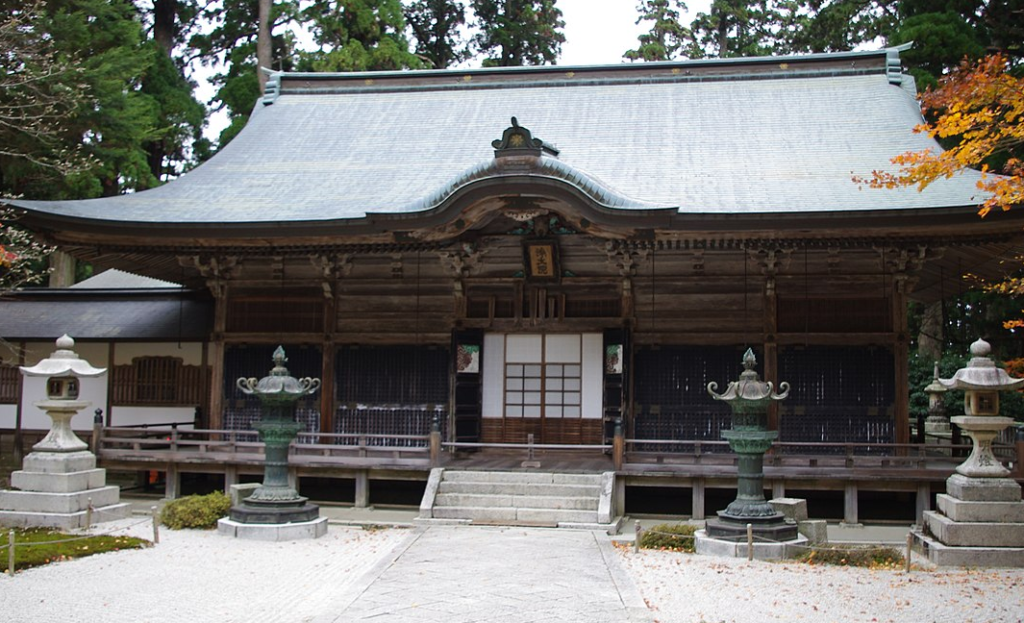
The Main Hall of Jodo-in at Enryaku-ji Temple (Important Cultural Property)
参考資料と学術研究
最澄、または伝教大師として知られる人物は、日本の天台宗を開創した重要な僧侶です。
彼の影響は、比叡山延暦寺の創建や、『摩訶止観』といった著作を通じて、仏教の教えと実践の発展に大きく寄与しました。
延暦寺は、天台宗の中心地として、多くの学僧を育成し、日本仏教の発展に不可欠な役割を果たしてきました。
最澄の教えは、大乗仏教の理念に基づいており、特に『法華経』に深い敬意を払っています。
彼は、日本における大乗戒壇、すなわち戒律を授ける場としての重要性を確立しました。
これらの戒壇は、修行僧が仏教の教えに従って生きるための道を提供するものとされています。
伝教大師最澄に関する学術研究は、彼の著作や歴史的背景、天台宗の教義の解釈に関連する文献を含んでいます。
これらの研究は、歴史学、宗教学、哲学など多岐にわたる学問領域において重要な参考資料となっています。
天台宗関連の研究は、比叡山延暦寺での修行体系や教義の伝播、さらには最澄の思想が後世の宗教や文化に与えた影響についても探求しています。
これらの研究は、日本の仏教史を理解する上で欠かせない情報源となっており、学術的な議論を深めるために不断の努力が続けられています。
伝教大師最澄に関する主要な文献
伝教大師最澄に関する主要な文献は、彼が日本の天台宗を開いた重要な宗教指導者であることを示す貴重な資料です。
最澄が比叡山延暦寺を設立し、『摩訶止観』を著したことは、彼の教えとその影響力を理解する上で欠かせない情報となっています。
最澄は大乗戒壇を確立し、『法華経』の教えを広めたことで知られており、これらの活動は天台宗の教義と実践の基礎を形成しました。
伝教大師最澄に関する文献には、彼の著作だけでなく、後世の学者たちによる研究や論文も含まれます。
これらの文献は、最澄の思想とその時代背景を深く掘り下げ、彼が日本仏教に与えた影響の大きさを明らかにしています。
また、天台宗関連の研究は、比叡山延暦寺をはじめとする天台宗の寺院や遺跡の考古学的な調査結果をもとに、宗教的な実践や儀式に関する新たな知見を提供しています。
これらの文献は、最澄の教えとその実践が現代にどのように受け継がれているかを理解するための基盤となり、天台宗の教義や歴史に関心を持つ研究者や宗教学の学生にとっては貴重な資源です。
伝教大師最澄についての研究は今も進行中であり、彼の教えが持つ普遍性と現代社会への適用可能性を探る試みが続けられています。
天台宗関連の研究とその進展
天台宗関連の研究とその進展についての考察は、日本の仏教史における重要な一環を成しています。
最澄、またの名を伝教大師は、日本天台宗の開祖として知られ、その教えは比叡山延暦寺を中心に広まりました。
彼が著した『摩訶止観』は、修行法の核心をなす文献であり、今日に至るまで多くの研究がなされています。
また、大乗戒壇の確立は、彼の教えが組織的な宗教運動に発展する基盤を築きました。
最澄の思想に深く影響を与えた『法華経』は、天台宗の教義形成において中心的な役割を果たしており、その解釈に関する研究は絶え間なく進展しています。
伝教大師最澄に関する主要な文献は、彼の生涯や哲学、そして比叡山延暦寺との関連性を探求する上で不可欠な資料とされています。
近年の研究では、最澄の教えがどのように現代に適用され、またどのように解釈されているかに焦点が当てられています。
天台宗関連の研究は、古典文献の分析から現代社会における宗教の役割まで、幅広いテーマをカバーしており、その進展は学問的な興味を超えて、実生活における宗教の意義を再評価するきっかけを提供しています。
References and Academic Research
Known as Saicho or the Great Teacher of Propagation, this figure is a crucial monk who founded Japan’s Tendai Buddhism.
His influence, through works like the establishment of Mt. Hiei’s Enryaku-ji Temple and his text “Maka Shikan,” significantly contributed to the development of Buddhist teachings and practices.
Enryaku-ji Temple has served as the epicenter of Tendai Buddhism, nurturing many scholars and playing an indispensable role in the advancement of Japanese Buddhism.
Saicho’s teachings are rooted in the ideals of Mahayana Buddhism, particularly showing deep reverence for the “Lotus Sutra.”
He established the importance of the Great Ordination Platform in Japan, which serves as a place for imparting precepts based on the teachings of the Lotus Sutra.
Academic research on Saicho, the Great Teacher of Propagation, includes literature related to his writings, historical context, and interpretations of Tendai doctrines.
These studies are essential reference materials across various academic disciplines such as history, religious studies, and philosophy.
Research related to Tendai Buddhism explores the training systems at Enryaku-ji Temple, the propagation of doctrines, and investigates the influence of Saicho’s ideas on subsequent religious and cultural developments.
These studies are vital sources of information for understanding Japanese Buddhist history and continue to contribute to scholarly discussions through ongoing efforts.
Key Literature on the Great Teacher of Propagation
Key literature on the Great Teacher of Propagation provides invaluable insights into his role as a seminal religious leader who founded Japan’s Tendai Buddhism.
Saicho’s establishment of Enryaku-ji Temple and his work “Maka Shikan” are crucial in understanding his teachings and their influence.
He is known for establishing the Great Ordination Platform and promoting the teachings of the Lotus Sutra, laying the foundation for Tendai Buddhism’s doctrines and practices.
Literature on the Great Teacher of Propagation includes not only his writings but also research and papers by subsequent scholars.
These texts delve deep into Saicho’s philosophy and historical context, illuminating the profound impact he had on Japanese Buddhism.
Furthermore, research related to Tendai Buddhism draws on archaeological findings from temples and sites like Enryaku-ji Temple to provide new insights into religious practices and rituals.
These literary works serve as a foundation for understanding how Saicho’s teachings and practices are transmitted to contemporary times, offering valuable resources for researchers and students of religious studies interested in Tendai Buddhism.
Research and Progress in Tendai Buddhism Studies
Consideration of research and progress in Tendai Buddhism studies constitutes a crucial component of Japanese Buddhist history.
Known as Saicho or the Great Teacher of Propagation, he is recognized as the founder of Japan’s Tendai Buddhism, with his teachings spreading primarily from Mt. Hiei’s Enryaku-ji Temple.
His work “Maka Shikan” forms the core of meditative practices, undergoing extensive study to this day.
Moreover, the establishment of the Great Ordination Platform laid the groundwork for his teachings to evolve into an organized religious movement.
The “Lotus Sutra,” profoundly influencing Saicho’s philosophy, occupies a central role in the formation of Tendai Buddhism’s doctrines, with ongoing research focusing on its interpretation.
Key literature on the Great Teacher of Propagation serves as indispensable documentation exploring his life, philosophy, and connection to Enryaku-ji Temple.
Recent studies have focused on how Saicho’s teachings are applied and interpreted in contemporary contexts.
Research related to Tendai Buddhism spans a wide range of topics from classical literature analysis to the role of religion in modern society, contributing beyond academic interest to re-evaluating the significance of religion in daily life.
まとめと最澄の教えの現代的意義
最澄、伝教大師として知られるこの偉大な僧侶は、日本の天台宗を創始し、その教えは比叡山延暦寺を中心に今も息づいています。
彼が残した『摩訶止観』は、心を鎮める修行法として、また大乗戒壇を通じて仏教徒の道を歩むための指針として、多くの人々に影響を与えてきました。
また、『法華経』の教えを日本に根付かせることにも尽力しました。
最澄の教えが今日に伝えるメッセージは、心の平穏を求める現代人にとっても価値があるものです。
彼の思想は、人々が内面の平和を見つけ、社会における調和を築くための基盤を提供します。
日本文化における天台宗の位置づけは、単なる宗教的枠組みを超え、日本人の価値観や生き方に深く根ざしていることがわかります。
比叡山延暦寺は、その教えを守り続ける場であり、精神文化の象徴とも言える存在です。
最澄の教えは、現代社会においても、心の豊かさを求める人々にとって、有用な指針を与えています。
彼の普遍的なメッセージは、時代を超えて受け継がれ、私たちの生活に静かながらも力強い影響を与え続けているのです。
最澄の教えが今日に伝えるメッセージ
最澄の教えが現代社会にもたらす洞察は、その普遍性にあります。
伝教大師として広く尊敬される彼は、日本の天台宗の開祖として知られ、比叡山延暦寺を中心にその教えを広めました。
彼の著作『摩訶止観』は、内省と外界の理解を深めるための実践的な指南書として今なお読み継がれています。
教えの核心にあるのは、『法華経』の理念を体現した大乗戒壇です。
これは、すべての存在が互いに繋がり、共に成長することを目指す場として機能します。
最澄が提唱したこの思想は、現代の個人主義が強調される中で、コミュニティの重要性を再認識させてくれるものです。
また、日本文化において天台宗は、宗教的な枠組みを超えて、芸術や文学、さらには社会倫理においても大きな影響を与えてきました。
最澄の教えは、精神性と日常生活の調和を促し、心の平穏を追求する道しるべとなり得るのです。
現代に生きる私たちにとって、最澄の教えから学べることは多くあります。
彼の智慧は、千年を超えても色褪せることなく、今日に伝えるメッセージとして受け継がれているのです。
日本文化における天台宗の位置づけ
日本の精神文化において、天台宗は重要な柱の一つとして存在しています。
この宗派は、最澄としても知られる伝教大師によって、平安時代に日本に伝えられました。
最澄は、中国で学んだ後、日本の天台宗の開祖となり、比叡山延暦寺を中心にその教えを広めました。
最澄が日本に持ち帰った教義は、『摩訶止観』に詳述されており、心を止めて観察することで真理に到達するという瞑想法が核となっています。
この教えは、大乗仏教の普遍性と包容力を体現し、『法華経』を中心とした教義は、多くの人々に受け入れられました。
伝教大師はまた、大乗戒壇を設立し、日本における仏教戒律の基盤を築きました。
この戒壇は、修行僧が戒律を受ける場として、また、精神性を高めるための場として機能しました。
日本文化における天台宗の位置づけは、単なる宗教的枠組みを超えています。
その哲学的な深さと、日常生活における実践的な教えは、日本人の生き方や価値観に深く根付いています。
最澄の教えが今日に伝えるメッセージは、心の平穏と社会の調和を求める現代人にとって、なお重要な意味を持ち続けているのです。
関連項目
関連項目には、天台宗に所縁のある寺院や文化財、そして最澄に敬意を表する様々な行事や記念施設が含まれます。
天台宗という宗派は、比叡山延暦寺を中心に広がり、その教えは多くの寺院や文化に影響を与えてきました。
伝教大師最澄は、日本の天台宗を開いた人物として知られ、彼の著作である『摩訶止観』は、宗派の教義を深く理解するための重要なテキストです。
また、大乗戒壇の設立者としても彼の名が挙げられます。
寺院に関しては、比叡山延暦寺のほかにも、天台宗に関連する多くの文化財が日本各地に存在します。
これらの寺院や文化財は、最澄の教えや『法華経』の普及に寄与してきた歴史的な場所であり、今も多くの人々に尊重されています。
最澄を顕彰する行事には、毎年比叡山延暦寺で行われる法要や、最澄の功績を記念する各種の式典があります。
また、最澄に関連する記念施設としては、彼の生涯や業績を展示する博物館や、彼を祀る神社などが訪れる人々の心を引きつけています。
これらの関連項目は、天台宗の歴史や最澄の教えに興味がある人々にとって、深い理解を得るための貴重な資源です。
それぞれの寺院や行事、記念施設は、日本の宗教文化の一端を垣間見ることができる窓口となっています。
天台宗に関連する寺院と文化財
天台宗は、日本の仏教宗派の一つで、比叡山延暦寺を総本山としています。
この宗派の開祖である最澄、別名伝教大師は、日本に天台宗を確立したことで知られています。
彼は中国から密教をもたらし、その教えを『摩訶止観』として体系化しました。
このテキストは、心を静めて悟りを開く修行法として今日でも多くの修行僧に読まれています。
延暦寺は、その歴史的な重要性から多くの文化財を有しており、大乗戒壇などの重要な建築物があります。
また、『法華経』を中心とした教義を説き、多くの寺院や文化財にその影響を残しています。
最澄が生きた平安時代から現代に至るまで、天台宗に関連する寺院は、その建築様式や宗教的な役割で日本の文化に大きな影響を与えてきました。
最澄を顕彰する行事としては、毎年比叡山延暦寺で開催される法要があります。
また、彼の功績を記念して建立された施設も多く、訪れることで最澄の精神と天台宗の教えに触れることができます。
これらの行事や施設は、最澄の教えが現代にも生き続けている証しであり、天台宗の寺院や文化財を訪れる多くの人々にとって、信仰の対象であり学びの場となっています。
最澄を顕彰する行事と記念施設
最澄とは、日本の天台宗を開いた伝教大師として知られる仏教僧です。
彼の教えは比叡山延暦寺において今も受け継がれており、『摩訶止観』や『法華経』の教えを中心に広まりました。
最澄の功績を称える行事や記念施設は、彼の思想と日本の仏教文化における重要性を今に伝えるものです。
比叡山延暦寺は、最澄が創建した寺院であり、天台宗の総本山として知られています。
この聖地では、最澄の命日である4月22日に「伝教大師大祭」という行事が毎年行われます。
この祭りでは、最澄が遺した教えを讃え、多くの僧侶や信者が集い、読経や法要が行われます。
また、最澄が確立した大乗戒壇は、比叡山の中でも特に神聖な場所とされ、信者たちが訪れる重要な巡礼地です。
最澄の教えに基づき、戒律を守ることの重要性が説かれ、多くの人々にとって精神性を高める場となっています。
記念施設としては、滋賀県にある最澄ゆかりの地に「最澄記念館」が設立されています。
この施設では、最澄の生涯や業績を紹介する展示が行われており、彼の思想や天台宗の歴史について学ぶことができます。
さらに、比叡山周辺には、最澄にまつわる多くの遺跡や文化財があり、これらは彼の教えが現代までどのように影響を及ぼしているかを物語っています。
最澄を顕彰するこれらの行事や記念施設は、日本の仏教文化を深く理解するための貴重な資源であり、最澄の思想がいかに日本の精神文化に根ざしているかを示しています。
外部リンク
天台宗公式サイトへのアクセスは、最澄や天台宗の教義について学びたい方にとって貴重な資源です。
ここでは、伝教大師としても知られる最澄の教えや、比叡山延暦寺にまつわる歴史的背景、さらには『摩訶止観』や大乗戒壇の重要性についての詳細情報が提供されています。
また、『法華経』に基づく宗教的実践や文化的影響に関する知見も得られるでしょう。
最澄と天台宗に関連するその他のウェブサイトも多数存在し、これらは日本の天台宗の開祖に関する追加情報や、比叡山延暦寺とその周辺の観光情報を提供しています。
これらのサイトでは、最澄の教えが現代にどのように影響を与えているか、また天台宗が日本の仏教文化においてどのような役割を果たしているかについての洞察を得ることが可能です。
これらのリンクを通じて、最澄の生涯や天台宗の深い教義に触れることで、仏教哲学に対する理解を深めることができます。
興味を持った方は、これらの外部リンクを訪れてみてはいかがでしょうか。
天台宗公式サイトとその資源
天台宗公式サイトは、最澄、または伝教大師として知られる日本の天台宗の開祖の教えと歴史を探究するための貴重な情報源です。
このサイトでは、比叡山延暦寺の由緒や『摩訶止観』の教義、大乗戒壇の意義、『法華経』の解説など、天台宗に関連する多岐にわたるトピックスが提供されています。
さらに、最澄の生涯や彼が残した影響、天台宗の修行体系についても詳細に学ぶことが可能です。
公式サイトでは、比叡山延暦寺をはじめとする天台宗の聖地についての情報も豊富に提供されており、訪れる際の参考になるでしょう。
また、『摩訶止観』をはじめとする天台宗の経典や教義に関する研究資料も充実しており、学術的な調査や個人的な学習に役立ちます。
天台宗公式サイトとその資源は、最澄の教えや天台宗の精神性を深く理解するための窓口となり、『法華経』の教えを現代に生かすヒントを提供しています。
このサイトを利用することで、大乗戒壇の重要性や天台宗の実践方法についても学ぶことができるため、宗教学研究者だけでなく、一般の興味を持つ人々にとっても価値あるリソースとなっています。
加えて、天台宗に関連するその他のウェブサイトへの外部リンクも提供されており、最澄や天台宗についての知識をさらに深めることが可能です。
これらのウェブサイトには、天台宗に関する最新の研究成果や、信者や学者が交流するためのフォーラムも含まれているため、天台宗に関心を持つすべての人々にとって有益な情報が集約されています。
最澄と天台宗に関するその他のウェブサイト
最澄、伝教大師として知られるこの偉大な僧侶は、日本における天台宗を創始しました。
彼の影響は比叡山延暦寺に今も息づいており、ここは彼の教えが集約された場所として尊ばれています。『
摩訶止観』は最澄の思想を深く理解する上で欠かせないテキストであり、大乗仏教の教義を具体化したものです。
また、大乗戒壇の構築は日本仏教における重要なマイルストーンとされており、『法華経』に基づいた実践と教義が今日に至るまで受け継がれています。
最澄と天台宗に関する情報を求める方々にとって、外部リンクは貴重な資源となるでしょう。
天台宗公式サイトは、最澄の教えや比叡山延暦寺に関する正確な情報を提供しており、信者だけでなく学術的な研究にも役立ちます。
さらに、最澄に関する研究論文や天台宗の歴史を掘り下げたウェブサイトも存在し、これらは仏教哲学に興味を持つすべての人々にとって有益な情報源です。
最澄の業績は、彼が築いた教団や文献によってのみならず、彼が残した精神的な遺産によっても評価されるべきです。
天台宗を探求する旅は、単なる歴史的な調査を超え、自己の内面と向き合う修行の一環とも言えるでしょう。
興味深いのは、最澄の思想が現代の宗教学や哲学においても重要な影響を与えている点です。
このように、最澄と天台宗に関するその他のウェブサイトは、歴史的な背景から現代に至るまでの影響、そしてそれらが現在の私たちの精神世界にもたらす意味を探求する上で、非常に価値のある資料となります。
これらのリソースを活用することで、最澄の生涯と天台宗の教えについて、より深い理解を得ることが可能です。
Here are the English translations of the provided Japanese texts:
Summary and Contemporary Significance of Saicho’s Teachings
Saicho, also known as Dengyo Daishi, is revered as a great Buddhist monk who founded Japan’s Tendai school, which continues to thrive around Mount Hiei’s Enryakuji Temple.
His work “Maka Shikan” has influenced many as a meditation practice to calm the mind and as a guide for Buddhists through the Mahayana precepts.
He also worked diligently to establish the teachings of the Lotus Sutra in Japan.
Today, Saicho’s teachings convey a message valuable to modern individuals seeking inner peace.
His philosophy provides a foundation for finding inner peace and building harmony within society.
The position of Tendai Buddhism in Japanese culture goes beyond mere religious framework, deeply rooted in Japanese values and ways of life.
Enryakuji Temple continues to uphold his teachings, symbolizing spiritual and cultural heritage.
Saicho’s teachings continue to provide useful guidance for those seeking spiritual richness in contemporary society.
His universal message transcends time, quietly but powerfully influencing our lives.
Messages Conveyed by Saicho’s Teachings Today
The insights Saicho’s teachings bring to contemporary society lie in their universality.
Widely respected as Dengyo Daishi, he is known as the founder of Japan’s Tendai school, spreading its teachings centered around Enryakuji Temple.
His work “Maka Shikan” continues to be read as a practical guide to deepen introspection and understanding of the external world.
At the core of his teachings is the Mahayana precept platform embodying the ideals of the Lotus Sutra.
This platform functions as a place aiming for interconnectedness and mutual growth among all beings.
Saicho’s philosophy emphasizes the importance of community amidst today’s emphasis on individualism.
Furthermore, Tendai Buddhism in Japanese culture has exerted significant influence not only in religious frameworks but also in arts, literature, and social ethics.
Saicho’s teachings promote harmony between spirituality and daily life, guiding towards inner peace.
There is much for us living in the present to learn from Saicho’s teachings.
His wisdom continues to be passed down without fading over a millennium, serving as a message for today.
Positioning of Tendai Buddhism in Japanese Culture
In Japan’s spiritual culture, Tendai Buddhism exists as a crucial pillar.
Founded by Saicho, also known as Dengyo Daishi, this sect was introduced to Japan during the Heian period.
After studying in China, Saicho became the founder of Tendai Buddhism in Japan and spread its teachings centered around Enryakuji Temple.
The doctrines Saicho brought back to Japan are detailed in “Maka Shikan,” emphasizing reaching truth through meditation and observing the mind.
These teachings embody the universality and inclusiveness of Mahayana Buddhism, with doctrines centered around the Lotus Sutra being widely accepted.
Dengyo Daishi also established the Mahayana precept platform, laying the foundation for Buddhist precepts in Japan.
This platform served as a place for monks to receive precepts and to elevate spirituality.
Tendai Buddhism’s position in Japanese culture transcends mere religious frameworks.
Its philosophical depth and practical teachings in daily life are deeply rooted in Japanese ways of life and values.
The message conveyed by Saicho’s teachings today remains significant for modern individuals seeking inner peace and social harmony.
Related Topics
Related topics include temples and cultural assets associated with Tendai Buddhism, as well as various events and commemorative facilities honoring Saicho.
The Tendai sect, centered around Enryakuji Temple, has spread its teachings to many temples and cultural influences.
Dengyo Daishi Saicho is known as the founder of Tendai Buddhism in Japan, and his work “Maka Shikan” is an essential text for understanding the sect’s doctrines.
He is also recognized as the founder of the Mahayana precept platform.
Apart from Enryakuji Temple, many cultural assets associated with Tendai Buddhism exist throughout Japan.
These temples and cultural assets are historically significant places that have contributed to the dissemination of Saicho’s teachings and the doctrines centered around the Lotus Sutra.
Saicho’s teachings serve as a guidepost for promoting harmony between spirituality and daily life, pursuing inner peace.
There is much to learn from Saicho’s teachings for those of us living in the contemporary world.
His wisdom continues to be passed down through the ages, exerting a quiet yet powerful influence on our lives.
Events Commemorating Saicho and Commemorative Facilities
Saicho, known as Dengyo Daishi, is a Buddhist monk known for founding Tendai Buddhism in Japan.
His teachings continue to be passed down at Enryakuji Temple, focusing on the Lotus Sutra and “Maka Shikan.”
Events and facilities commemorating Saicho’s achievements convey his thoughts and significance in Japanese Buddhist culture.
Enryakuji Temple, founded by Saicho, is renowned as the headquarters of Tendai Buddhism.
Annually on April 22nd, his death anniversary, the “Dengyo Daishi Grand Festival” is held here.
During this festival, Saicho’s teachings are honored, and many monks and believers gather to chant sutras and conduct ceremonies.
The Mahayana precept platform established by Saicho is considered particularly sacred within Mount Hiei and serves as an important pilgrimage site for believers.
Based on Saicho’s teachings, the importance of observing precepts is emphasized, serving as a place to enhance spirituality for many.
In Shiga Prefecture, the “Saicho Memorial Museum” has been established as a commemorative facility associated with Saicho’s legacy and achievements.
This facility showcases exhibitions on Saicho’s life and achievements, allowing visitors to learn about his thoughts and the history of Tendai Buddhism.
Furthermore, around Mount Hiei, many relics and cultural assets associated with Saicho are found, illustrating how his teachings have influenced contemporary times.
Events and facilities commemorating Saicho serve as valuable resources for deepening understanding of Japanese Buddhist culture, showing how Saicho’s thoughts are deeply rooted in Japan’s spiritual culture.
External Links
Access to the official Tendai Buddhism website is a valuable resource for those wishing to learn about Saicho and Tendai Buddhism’s doctrines.
Here, detailed information is provided on Dengyo Daishi Saicho’s teachings, the historical background of Enryakuji Temple, and the significance of “Maka Shikan” and the Mahayana precept platform.
Insights into religious practices based on the Lotus Sutra and their cultural impact can also be gained.
Other websites related to Saicho and Tendai Buddhism also exist, providing additional information on Japan’s founder of Tendai Buddhism and tourist information around Enryakuji Temple and its surroundings.
Through these links, insights into how Saicho’s teachings continue to influence contemporary society and the role of Tendai Buddhism in Japanese Buddhist culture can be obtained.
Exploring these external links offers opportunities to deepen understanding of Saicho’s life and Tendai Buddhism’s profound doctrines.
Tendai Buddhism Official Site and Resources
The official Tendai Buddhism website is a valuable source of information for exploring the teachings and history of Japan’s founder of Tendai Buddhism, known as Dengyo Daishi.
This site offers a wide range of topics related to Tendai Buddhism, such as the history of Enryakuji Temple, the doctrines of “Maka Shikan,” the significance of the Mahayana precept platform, and explanations of the Lotus Sutra.
Detailed studies on Saicho’s life, his influence, and the training system of Tendai Buddhism are also available.
The official site provides abundant information on sacred sites of Tendai Buddhism, including Enryakuji Temple, which will be useful for planning visits.
Furthermore, research materials on Tendai Buddhism scriptures and doctrines, including “Maka Shikan,” are extensive and useful for academic research and personal learning.
The Tendai Buddhism official site and its resources serve as a gateway to deeply understanding Saicho’s teachings and the spirituality of Tendai Buddhism, offering insights into how the teachings of the Lotus Sutra are applied in contemporary times.
This site is a valuable resource not only for religious studies but also for those interested in Saicho and Tendai Buddhism, providing insights into the importance of the Mahayana precept platform and practical approaches in Tendai Buddhism.
Additionally, links to other websites related to Tendai Buddhism are provided, offering further information on Japan’s founder of Tendai Buddhism and tourist information around Enryakuji Temple and its surroundings.
These websites consolidate valuable information for those interested in understanding how Saicho’s teachings have influenced contemporary times and the exploration of Saicho and Tendai Buddhism’s impact on our spiritual world today.
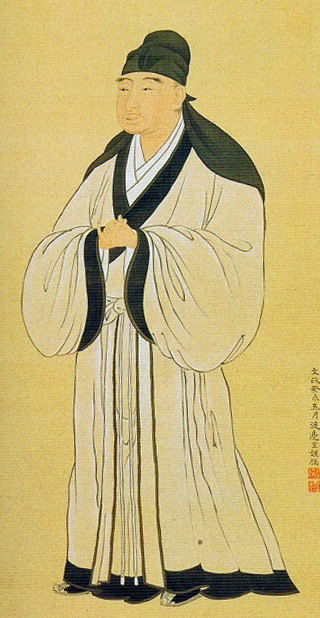
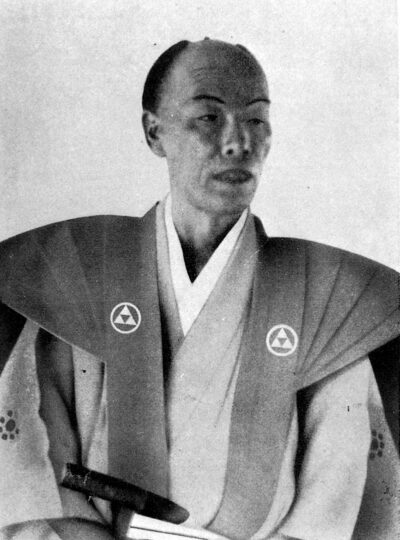
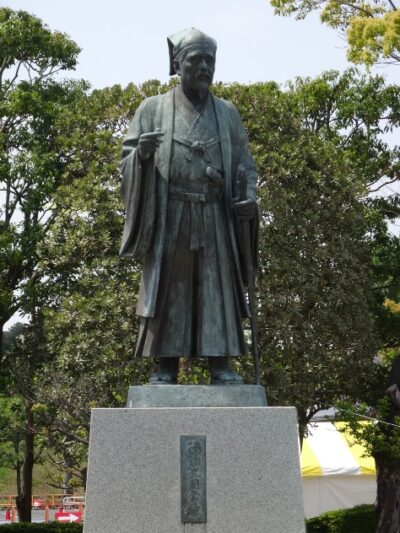
Warning: Undefined variable $comment_form_sns_tags in /home/ktsky/philosophy-kayak.com/public_html/wp-content/themes/shaper/comments.php on line 27